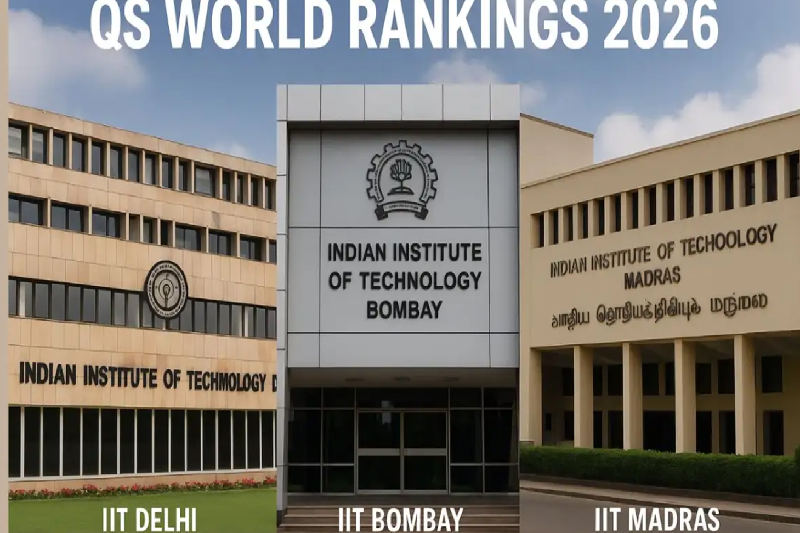
India’s IITs Slip in QS Asia Rankings 2026 Amid Surge by Chinese and Singaporean Universities
The latest QS Asia University Rankings for 2026 reveal a challenging landscape for India’s top higher education institutions. Despite incremental improvements in their individual scores, nine of the top ten Indian institutions, including seven Indian Institutes of Technology (IITs), have seen a sharp decline in their rankings this year. Meanwhile, universities from China, Singapore, South Korea, and Malaysia have surged ahead, highlighting the intensifying competition in East and Southeast Asia.
Top Indian Institutions See Rank Drops
According to QS Quacquarelli Symonds, the global higher education analytics firm, India’s premier institutes are facing a relative decline in their Asian standing. Among the top 10 Indian universities, IIT Delhi, IIT Madras, IIT Bombay, IIT Kanpur, and IIT Kharagpur have all recorded their lowest ranks in recent years.
IIT Delhi, the highest-ranked Indian institution for the second consecutive year, fell to 59th place from last year’s 44th position. Between 2021 and 2025, its rank fluctuated narrowly between 44 and 47, making this year’s 15-rank fall particularly notable. IIT Bombay experienced the steepest drop, falling 23 positions to 71st place. Historically, IIT Bombay has been the highest-ranked Indian institution in the QS Asia rankings from 2021 to 2024, with ranks ranging from 37 to 42.
In contrast, the only Indian institution in the top 10 to register an improvement was Chandigarh University, a private university, which rose from 120th to 109th place.
Asian Universities Dominate the Top Ranks
The 2026 QS Asia rankings paint a clear picture of Asian higher education trends. The University of Hong Kong tops the list, overtaking China’s Peking University, which now ranks second. Singapore’s National University of Singapore (NUS) and Nanyang Technological University (NTU) share third place, while Fudan University in China and Hong Kong University of Science and Technology complete the top six. Other institutions from Hong Kong and China, such as the Chinese University of Hong Kong, City University of Hong Kong, Tsinghua University, and Hong Kong Polytechnic University, occupy positions seven through ten.
QS analysts note that the region’s top performers are concentrated in East and Southeast Asia. This “eastward concentration” is driven by sustained investment in research, faculty resources, and international engagement, allowing universities in China, Hong Kong, Singapore, South Korea, and Malaysia to consistently outperform their Indian counterparts.
Why Indian Institutes Are Losing Ground
Interestingly, the rank drops do not reflect deteriorating performance. QS data show that Indian institutions have improved their total scores in 2026 compared to last year. However, other Asian institutions are improving at a faster pace, creating relative declines in ranking.
QS evaluates universities based on several metrics: academic reputation, employer reputation, faculty-student ratio, international research network, citations per paper, papers per faculty, staff with PhD, international faculty, international students, and student exchange programs.
Indian institutions, particularly IITs, score high on academic reputation, employer reputation, staff with PhD, and papers per faculty, with scores in the 80s and 90s. However, they lag in other key areas:
- Citations per paper: Measures research impact. IIT Delhi (31.5), IIT Bombay (20.0), and IIT Madras (20.3) have lower scores than top Asian peers, which often score in the high 90s. While these scores show slight year-on-year improvement, they are insufficient to close the gap.
- Faculty-student ratio: Reflecting teaching resources, IITs continue to face challenges. IIT Delhi has a score of 40.9, while IIT Kharagpur scores only 16.5, compared with leading Asian universities scoring in the high 80s and 90s.
- International student ratio (ISR): Indicates global attractiveness. The top Asian institutions often score 100, whereas IITs range from just 2.5 (IIT Kharagpur) to 12.3 (IIT Roorkee). Low international student presence, combined with limited international faculty, remains a structural disadvantage.
QS emphasizes that Indian institutions are “retaining strong reputations” but are increasingly challenged by Asian universities excelling in research collaboration, output, and internationalization.
Expanded Rankings Increase Competition
The 2026 QS Asia rankings include 1,529 universities, with over 550 new entrants this year. China added 261 institutions, surpassing India, which added 137 new universities. This expansion has intensified competition and contributed to the volatility of ranks.
Among Indian universities, 105 out of 157 institutions (67%) saw a decline in ranking compared to last year. Despite this, the number of Indian institutions appearing in the rankings continues to grow, reaching a total of 294, while China leads with 395 institutions.
Regional Success Stories
The rankings also highlight countries making rapid progress. South Korean universities, such as Yonsei University and Korea University, have climbed steadily, now occupying top 20 positions. Malaysia’s Universiti Malaya and Universiti Putra Malaysia also made significant gains, driven by improvements in faculty-student ratios and internationalization metrics.
This pattern reflects strategic national investment in higher education, research collaboration, and global engagement—areas where Indian institutions have yet to match their Asian peers in scale and pace.
India’s Top 10 Institutions: 2026 vs Previous Years
|
Institute |
2026 |
2025 |
2024 |
2023 |
2022 |
2021 |
|
IIT Delhi |
59 |
44 |
46 |
46 |
45 |
47 |
|
IISc |
64 |
62 |
58 |
52 |
56 |
56 |
|
IIT Madras |
70 |
56 |
53 |
53 |
54 |
50 |
|
IIT Bombay |
71 |
48 |
40 |
40 |
42 |
37 |
|
IIT Kanpur |
77 |
67 |
63 |
66 |
64 |
72 |
|
IIT Kharagpur |
77 |
60 |
59 |
61 |
60 |
58 |
|
Delhi University |
95 |
81 |
94 |
85 |
77 |
71 |
|
Chandigarh University |
109 |
120 |
149 |
185 |
271-280 |
- |
|
IIT Roorkee |
114 |
108 |
116 |
114 |
109 |
103 |
|
IIT Guwahati |
115 |
104 |
111 |
124 |
119 |
117 |
The data show a clear trend: even India’s premier institutes are experiencing relative decline as regional peers accelerate their global competitiveness.
Conclusion
The QS Asia Rankings 2026 highlight a competitive shift in higher education across Asia. While Indian institutions maintain strong academic and reputational scores, structural challenges in internationalization, research visibility, and faculty-student ratios have caused significant relative declines. At the same time, universities in China, Singapore, Hong Kong, South Korea, and Malaysia are moving rapidly upward, benefiting from focused investment and global engagement.
For India, this is a call to action: strengthening research output, improving faculty-student ratios, and enhancing internationalization are critical for maintaining competitiveness in Asia’s rapidly evolving academic landscape.



